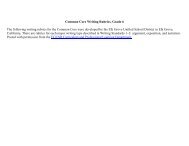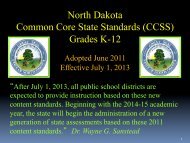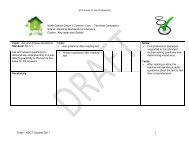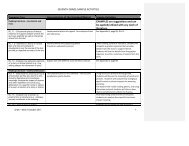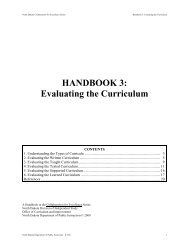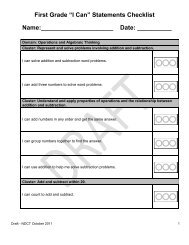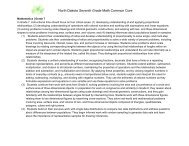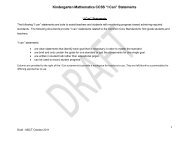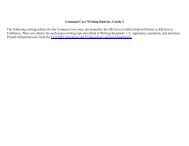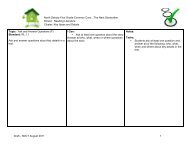A. ND Mathematics Content Standards, Grade 5 - ND Curriculum ...
A. ND Mathematics Content Standards, Grade 5 - ND Curriculum ...
A. ND Mathematics Content Standards, Grade 5 - ND Curriculum ...
Create successful ePaper yourself
Turn your PDF publications into a flip-book with our unique Google optimized e-Paper software.
<strong>Mathematics</strong> | <strong>Standards</strong> for Mathematical Practice<br />
The <strong>Standards</strong> for Mathematical Practice describe varieties of expertise that mathematics educators at all levels should seek to develop in their students.<br />
These practices rest on important “processes and proficiencies” with longstanding importance in mathematics education. The first of these are the NCTM<br />
process standards of problem solving, reasoning and proof, communication, representation, and connections. The second are the strands of mathematical<br />
proficiency specified in the National Research Council’s report Adding It Up: adaptive reasoning, strategic competence, conceptual understanding<br />
(comprehension of mathematical concepts, operations and relations), procedural fluency (skill in carrying out procedures flex ibly, accurately, efficiently and<br />
appropriately), and productive disposition (habitual inclination to see mathematics as sensible, useful, and worthwhile, coupled with a belief in diligence<br />
and one’s own efficacy).<br />
1. Make sense of problems and persevere in solving them.<br />
Mathematically proficient students start by explaining to themselves the meaning of a problem and looking for entry points to its solution. They analyze<br />
givens, constraints, relationships, and goals. They make conjectures about the form and meaning of the solution and plan a solution pathway rather than<br />
simply jumping into a solution attempt. They consider analogous problems, and try special cases and simpler forms of the original problem in order to gain<br />
insight into its solution. They monitor and evaluate their progress and change course if necessary. Older students might, depending on the context of the<br />
problem, transform algebraic expressions or change the viewing window on their graphing calculator to get the information they need. Mathematically<br />
proficient students can explain correspondences between equations, verbal descriptions, tables, and graphs or draw diagrams of important features and<br />
relationships, graph data, and search for regularity or trends. Younger students might rely on using concrete objects or pictures to help conceptualize and<br />
solve a problem. Mathematically proficient students check their answers to problems using a different method, and they continually ask themselves, “Does<br />
this make sense” They can understand the approaches of others to solving complex problems and identify correspondences between different<br />
approaches.<br />
2. Reason abstractly and quantitatively.<br />
Mathematically proficient students make sense of quantities and their relationships in problem situations. They bring two com plementary abilities to bear<br />
on problems involving quantitative relationships: the ability to decontextualize—to abstract a given situation and represent it symbolically and manipulate<br />
the representing symbols as if they have a life of their own, without necessarily attending to their referents—and the ability to contextualize, to pause as<br />
needed during the manipulation process in order to probe into the referents for the symbols involved. Quantitative reasoning entails habits of creating a<br />
coherent representation of the problem at hand; considering the units involved; attending to the meaning of quantities, not just how to compute them; and<br />
knowing and flexibly using different properties of operations and objects.<br />
North Dakota <strong>Mathematics</strong> <strong>Content</strong> <strong>Standards</strong><br />
Based on the Common Core State <strong>Standards</strong><br />
Introduction 5 June 2011



